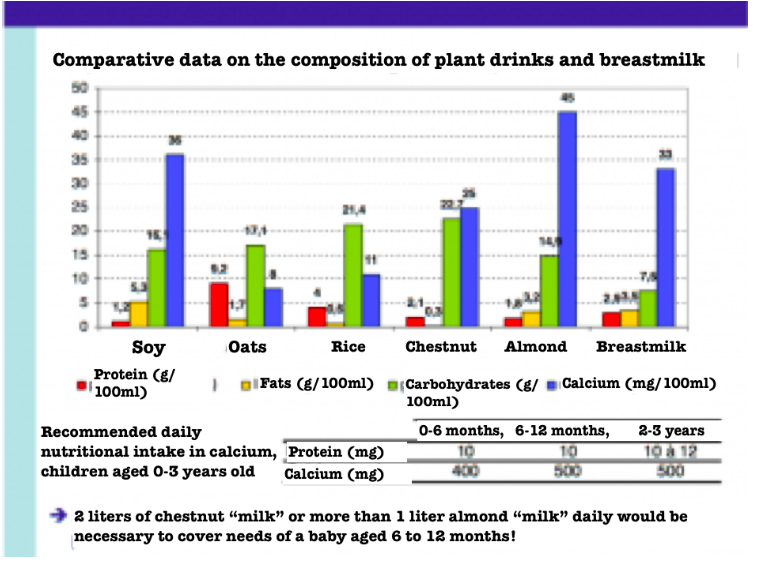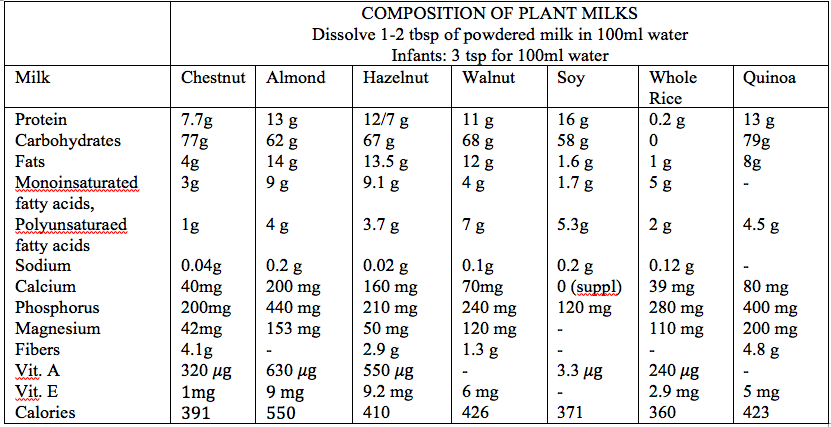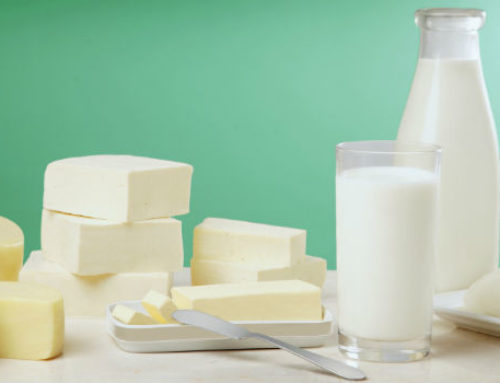Letter No. 7 by Christine Bouguet-Joyeux – 2nd of May, 2018
3- Animal and Plant Baby Formula
Dear friends,
Among the many questions you ask, many regard baby nutrition.
Many options are available. But in order to keep the best possible attitude with regard to each, we decided to study all available nutritional solutions, starting from the most natural and best one: breastfeeding.
Indeed, adopting breastfeeding has immune, physical, neurological and affective implications. Breastmilk does not trigger any allergy in the child if the mother is healthy. You can find all scientific arguments in favor of breastfeeding in the No. 123 Letter of Professor Henri Joyeux on his website: www.professeur-joyeux.com
In Part II of this letter, we studied and compared different features of animal milks, and explained the pros and cons for each. In particular, we laid out potential allergy issues.
The fact remains that breastfeeding is ideal for infants’ health. According to the World Health Organization’s recommendations, if the mother is healthy, 6 months of excusive breastfeeding are recommended, along with one additional year of partial breastfeeding, once every morning and every night.
This third letter is a study of what the market has to offer among artificial animal and plant milks. These milks are industrially manufactured and adapted to infants’ nutrition, and have their own health benefits. In order to make the best choices depending on your own situation, your child’s, and your family, you need to be well informed. That is what we aim for.
Thank you for your questions that motivated us to write this article on breastfeeding and baby nutrition at www.famillessanteprevention.org.
Reasons for Manufacturing Industrial Artificial Milks
Impossible Breastfeeding or Intolerance to Animal Milks
Mom’s Choice Not to Breastfeed
Real Impossibility to Breastfeed
Diverse Intolerances In Infants
These include reflux, regurgitation, sleep disorders, transit issues such as diarrhea or constipation, skin issues (eczema, rash), slow(ed) weight intake. Most common intolerances and their symptoms include:
The best “diet” for the future mother, to start even before she gets pregnant, is the Mediterranean diet. It is the very definition of a healthy diet. Adopting it is the best way to teach your child to love fruits and vegetables in the long run, and animal products like fresh fish, organic eggs, meat (especially poultry), raw extra virgin olive oil, and a gentle method of cooking. Indeed, mothers transmit the taste of foods to their child already in utero and later through breastfeeding. A taste for natural healthy foods can develop very early on in a child’s life.
We particularly recommend to start with fresh pureed vegetables (preferably soft-steamed cooked, for a short time, to respect colors and texture), with a little extra virgin olive oil, one a day for two weeks
Then,
Progressively add one additional puree every night
In the meantime you can start adding protein to lunch (give animal protein at lunch rather than night to avoid disturbing sleep, starting with small quantities).
half a tbsp organic soft-boiled egg (starting with the yolk, easier to digest) that has been cooked in a soft steam cooker for 5 to 6 minutes [2]. Two days later, one half a tbsp steamed white fish blended in a little soup.
Two to three days later, one half a tbsp chicken or turkey breast.
Once you begin introducing protein because you are slowing down with breastfeeding, you will need introduce animal proteins to replace the proteins previously provided by breastmilk. Throughout the diversification, vary protein intake every other day (one day poultry, later fish, etc.), without forcing baby to eat everything, respecting a slowed progression.
If digestion seems a little disturbed, space with one or two more days between new protein form. Slowly, you will be able to give your child one such meal type per day (along with the vegetable-purée only for the evening meal). The next month, you can progressively increase doses.
Do not underestimate the impact of preparation, sterilization, dehydration, and industrial conservation on the nutritional and digestive quality of the prepared baby foods you could buy. Nothing can come close nor match the quality of breastmilk infants nurse every morning and evening after 6 months of exclusive breastfeeding.
Return to work and the efficiency of artificial milk advertisements are to blame for the fact that, at least in France, most infants are only breastfed for only 2 to 3 months. And yet, people know that it is possible to maintain breastfeeding to some degree, for example twice to three times daily after going back to work. Moreover, an infant’s or his mother’s fragile health can justify an extension of maternity leave – when possible – or time off for medical reasons.
Manufacturing “Growth” Milks for Baby’s First Year
Necessary Contents: Imitating Breastmilk, From The Ideal to Bad Copies.
For decades, the food processing industry has applied itself to correct the composition of its artificial milks so as to adapt them to babies, more or less successfully. They aim to get as close possible to the ideal model: breastmilk. The parameters corrected by the industry (European norms) include:
– “Correction” of the difference in composition of breastmilk and animal milks: The industry takes off, among others, protein, fats, and lactose from animal milks… The list of corrections is so long it should make us reflect on the benefits of feeding more or less artificial animal milks to our babies.
– Addition of ingredients “present in breastmilk”: long chain polyunsaturated fatty acids DHA (Omega 3 fatty acids), so baby can be “more intelligent”, vitamins and minerals (iron), probiotics (lactic ferments such as the ones in highest numbers in mothers’ breastmilk: active bifidus.
On allergies to animal milk’s protein
The industry tries to fulfill infants’ age-based nutritional needs with formula, which proteins have been extensively hydrolyzed.
These so-called HypoAllergenic (HA) formula aren’t recommended because they are derived from animals. They have a similar protein composition as other animal species’ milks (goat, sheep, mare, donkey, camels), but in different proportions. Moreover, the protein structure of formula and these milks are equivalent.
Such formula is advocated by specialists as “preventative”, suited for children with a family history of allergy. This seems risky, as parents usually go from one HA milk to the next without finding relief from tolerance issues. Let us stress that these same specialists do not recommend to stop these milks in case of CMPA (cows’ milk protein allergy) or lactose intolerance.
So-called “Artificial” Animal Milks: “Replacement” Milks, or “Infant Milks”
There is a real jungle of brands and formula types. It is difficult to make your way through them as parent, let alone to decide which kind to prioritize. The only remaining reliable reference remains… human breastmilk !
The Association de pédiatrie ambulatoire Languedoc Roussillon (Southern French ambulatory pediatrics association) published an interesting report on infant formula, and started with precise indications :
“Children’s nutrition from birth to 4 to 6 months of age should be an exclusive milk-based nutrition, up until food diversification. The latter should not be started before 4 months, if possible not before 6 months. Breastmilk remains the best choice for infant nutrition and must be preferred. Ideally, children should be fed exclusively with [breastmilk] for 6 months. Nursing should be equivalent in volume to amounts of formula received [by non-breastfed children] during diversification. Infant formula is used when children are not breastfed, or as breastmilk complement.” [3]
Products classification:
– Birth to 4-6 months: Stage 1 milks or milk preps for infants.
– 4-6 months to 12 months: Stage 2 formula or milk preparations contain more protein, more carbohydrates, less fats, more minerals, more energy.
– 10-12 months to 3 years and older: Stage 3 formula or baby foods composition are very close to the one of preparations meant for older children. However, in the industry, the difference between the composition of baby foods other than stage 1 (before and after age 12 months.) tend to get more similar.
“Formula” Milks and Breastmilk: From the Ideal to The Bad Copy
Is it possible to replicate breastmilk? Results are unconvincing.
Components aren’t identical to the maternal model. There are significant differences in the composition of animal milks, logically adapted to animal’s offspring, and human breastmilk. Moreover, all industrial processes degrade the prime quality of these milks as well as their digestibility. Hence digestive disorders, assimilation issues, degraded bioavailability and gut absorption difficulties are understandable. Such disorders include reflux, regurgitation, sleep disorders, diarrhea or constipation, rashes (eczema and erythema), slow weight intake…
Breastmilk composition is not accurately replicable
– Some of breastmilk components are not replicable, especially the growth factors tailored to infants’ nervous system and their brain.
– Human breastmilk components vary too greatly to be matched by infant formula. Maternal milk is a living and dynamic substance. It adapts to babies’ needs, to the preemie’s needs as well as to the full-term baby to his growth and his age. [4]
– Human breastmilk is directly serviceable to the baby. It does not undergo industrial transformation or conservation techniques. Its components – minerals, trace elements, polyunsaturated fats, mother’s lactose, protective immunoglobulin or even CD4 or T4 lymphocytes, which are so important to the protection of infant’s immunity (See Letter No. 5) – are naturally present, fresh and remain intact in the infant’s digestive system, and are adapted to their digestion, assimilation, and absorption.
From the ideal to the copy
French and European Union law imposes composition brackets are on the milk industry. Their parameters are calculated by the industry. But are they really efficient, besides what manufacturers and their medical allies declare in order to get marketing authorization?
However, pediatricians are constant: “The food processing industry that manufactures baby formula all try to come ever closer to the composition of breastmilk, which naturally remains what is best for your baby.” [5]
So, what are formula really made of?
– As to carbohydrates: The industry uses cow’s milk lactose, and add (plant) maltose dextrin to supplement in calories.
– Starches or carob flour are added to thicken anti-reflux milks. Yet, if a baby rejects a milk, that means it is not suited to him. Why should we force it on him ?
– Milks are made lactose-free through industrial techniques, to adapt to a lack of a lactose digestive enzyme, lactase in babies’ system. This deficiency expresses itself through frequent diarrhea, which is another sign of rejection.
– Proteins: Protein amounts vary in quantity depending on whether they are meant for full-term babies (currently: 1.5 to 1.9 g/kg/day), or for preemies (3.5 to 4 g/kg/day). Sometimes, formulas contain soluble proteins, which are easier to digest.
– Total or partial hydrolysis of proteins is meant to make them less allergenic.
– Amino acid distribution is modified: Food-processing industry transforms the aminogram, decreasing threonine, too abundant in cow’s milk, and increasing tryptophan, which is insufficient.)
– CMP-free formula (with no cows’ milk protein): These are made for infants or older. They contain soy, pork collagen. They should absolutely be avoided. Horror!
– Replacement lipids are vegetable sourced (non-dairy). They are linoleic acid, alpha linoleic acid, precursor (infant formula), ARA (arachidonic, Omega 6), EPA & DHA (Omega 3), and superior derivatives (necessary in preemies’ milk) meant for brain and vision development.
–Intestinal flora modificatory, meant to stimulate flora: probiotics. They improve intestinal transit.
– Milks acidified with lactic ferment to facilitate digestion.
Organic Milks: Dynamic Research
In France, there are many available solutions in the organic market. They are relatively similar to formula available on conventional market, which increasingly comes up with organic milks to win back the global formula market:
– Anti-regurgitation (or anti-reflux) formula, enriched with carob extracts, corn, rice or potato starch;
– HypoAllergenic : processed through enzyme hydrolysis, sometimes heating, for an uniquely preventative effect;
– Prebiotic or probiotics enriched;
– Transit milks : contain less lactose, protein, and casein;
– Acidified milks;
– Satiation milks, contain more complex sugars, and protein containing casein;
– Formula low in lactose, meant to avoid colic due babies’ natural lactase deficiency;
– Infant formula containing superior derivatives of essential fatty acids;
– Lactose-free antidiarrhea formula, also deproteinated or containing hydrolyzed protein.
On the organic market, one can observe an openness to vegetable solutions. Rice is most common, and its use implies enrichment since rice proein base is less nutritionally rich ( see comparative table below).
There are many organic formula brands: Babybio, HIPP, Prémibio, Holle, auxquelles s’ajoutent Guigoz Bio 2, Modilac Bio 2, Optima 2, Physiolac Bio 2, Priméa 2…
However, organic formula do not escape contamination risks : In 2018 manufacturer Prémibio had to recall 2000 formula boxes because of “enterobacteria contamination risks” [6]
Alerts : Presence of Aluminum, Salmonella… Shows That There is No Such Thing as Risk-Free Industrial Milk
- The French Lactalis[7] case, 2017
In 2017, 12 batches of formula Picot-Pepti junior, Lactel-Milumel, Picot-Sans Lactose (lactose free), were recalled from the market, as well 1 stage PICOT® Rice.
Internet website immediately proposed replacements to formula, pointing to the ones that should be avoided. [8]
- Avoid aluminum in infants formula
British researchers found aluminum, a potentially neurotoxic trace element, in non-negligible quantities in infant formula available on the British market.
In March 2014, French consumer review 60 Millions de consommateurs published the results of its study on the presence of aluminum in 28 powder infant formula (1st and 2nd stage), as well as 9 liquid growth milks (adapted to 1-3 year-olds) sold on the French market. “Results are far from satisfactory: if we did not detect the presence of aluminum in analyzed growth milks, we found some in more than half of infant formula samples.”
– In first stage milks, we found on average 153 micrograms (μg) aluminum per liter ( 1 liter is about a quart). Therefore, a 6-months-old infant drinking 4 baby bottles of 210 ml (7.1 oz) per day would ingest 897 μg aluminum per week. Results are no better for 2nd stage formula. On average, they contain 198 μg/l, so the same infant drinking three 210 ml per day (since he started diversification) would ingest 874 μg aluminum per week.” [9]
If you told manufacturers, they would respond that such quantities do not exceed the tolerated maximum dose as defined by the European Food Safety Authority (EFSA). This dose is 1 mg per kg of body weight if consumed through the digestive tract [10]. It remains obvious that even with very low amounts accumulate in an infant’s blood, they will add up to eventually go past admissible doses, especially if the child suffers from intestinal porosity (See website in the notes below.)
Overall, The Widened Availability of Industrial Formula Solutions Does Not Really Solve Problems
This is the case for babies suffering from food intolerances When baby doesn’t tolerate powder formula meant for him (signs include, as stated above, regurgitations, vomiting, runny nose, rashes and eczema, erythema, cradle cap, belly pan, diarrhea and constipation), mommy will have to start trying “baby specific formula”, the hydrolyzed, de-proteinated, lactose-free, acidified, anti-reflux kinds, most of which contain soy…
Treatments of cow’s milk components do not protect children against digestive, respiratory and dermatological reactions. Just reading the list of components and additives tends to be dissuasive to mothers seeking to give their baby the best foods.
Finally, if your growing child communicates that he does not like milk, but eats everything else including fruits, meat and fish, you don’t need to impose animal dairy products on him. You can replace dairy with other animal protein (eggs, fish, chicken) or plant protein (legumes and nuts).
That’s the moments when you explore the question of so-called plant milks, as an alternative to animal milks, for allergic and intolerant children, or the ones with a family history of allergies and intolerance.
I know that many pediatricians do not look favorably on such alternatives. Our goal here is simply to try to see clearly, taking into account the age of the child, his progression through food diversification, and of the nature of each plant product available to him.
Plant Milks: Almond, Hazelnut, Chestnut, Walnut, Rice, Quinoa, Soy, Oats, etc.
So-called almond, quinoa, hazelnut, walnut, and chestnut “milks” or “juices”, and especially rice and oats, are usually not recommended in the framework of exclusive nutritional solution, because they are “nutritionally unsuitable” to baby’s growth. For this very reason, one should at the very least change milks regularly on account of taste diversity and nutritional efficacy. Parents should also not use plant milks alone: they could be a complement to breastfeeding (after nursing twice a day), and should not be given too early in the infant’s life (after age 4 to 6 months). They can be given within the framework of food diversification and solids introduction from age 6 months. Therefore, plant milks should be used only in the framework of solids introduction. Let us add that when it comes to calcium contents, plant calcium is better assimilated (at a rate of 70%) than animal calcium (at a rate of 25%).
Comparative table of 7 plant milks (source : Christine Bouguet-Joyeux, Guide Pratique de Gastronomie Familiale)


For advertising reasons, or perhaps reasons pertaining to language rigidity, some refuse to apply the term “milk” to plant milks, and prefer using the term “drink” or “plant preparations,” which can be applied to any preparation made of fruits, vegetables or legumes, whether it is fresh or frozen, jarred or canned. This is a mistake, and it does not work. In the French language, “milk” refers to any preparation or dilution having the appearance of milk, whether it is nutritional, cosmetic (skin hydrating milk), or chemical (lime milk), which in no way can be referred to as “drink”.
Why Avoid Soy Milks
The most popular packed plant milk or drink is sterilized soy milk.
Firstly, let us clearly state that conservation degrades nutrients. Additionally, as for any other liquid plant milk, soy milk is full of additives, thickeners and sugar syrups, so that they can be tastier and more attractive and… addictive.
Moreover, one should warn against using soy milk with young children, especially in the as exclusive nutritional source. It shouldn’t even be used by the breastfeeding mother. Soy has high levels of plant-hormones, and has been linked to early puberty in children exclusively fed with soy sources because of their allergies to animal milks. It was pointed at in cases of premature growth of mammary glands in girls, or masculine hair growth in boys. In the long term, it could trigger soy allergies (and legumes allergies), thyroid problems. Also, it is poor in minerals (this is why it is always enriched in calcium) and vitamins, especially if sterilized at Ultra High Temperature (UHT).
Be aware that soy milk isn’t prepared, used, and preserved the same way in western countries and Asia. In Asia, soy is boiled for a long time, and the cooking water that is thrown away contains plant-estrogen and soy isoflavone. In our countries, the food processing industry uses 3 seconds-long Ultra High Temperature method to sterilize. Although it does sterilize soy, this method is too short to degrade plant-estrogens, but long enough to overcook them.
Finally, amounts of soy used in Asian countries are much inferior and less frequent than what is consumed in western countries’ through milk, tofu, tempeh, yoghurts and other sweetened deserts. For example, tofu is usually cut in very small pieces and represents only a small part of a Chinese meal.
Let us recall that adults with thyroid hypofunction should avoid soy, which contains goitrin, an enzyme inhibiting iodine absorption by the thyroid, and disturbs the formation of an essential hormone: T4. [11]
How Do Other Plant Milks Rate?
Other plant milks (see both tables above and below) vary in their minerals, fatty acid and vitamins composition, like the foods they stem from. Most often, they are advertised in liquid packs, but can sometimes be found in European organic stores.
A fluid UHT presentation also is also burdened by the addition of sugars and thickeners (meant to taste better and be more attractive) as well as preservative. This is why we prefer recommending powder milks. Adults can easily prepare their own nut drink: it is enough to soak almonds or other nuts overnight, and blend and filter them in the morning. It takes approximately a handful nuts to make a glass of milk.
Powdered plant milks (organic ones) bring in more fatty acids than soy milk. Processing methods respect their composition of minerals, vitamins and fatty acids. They can be used as replacement for cows’ milks in most recipes, and are economical, easy to transport and stock, and enjoyed very much by children.
These preparations have an exclusively vegetal origin. They contain carbohydrate, but no lactose, gluten, nor cholesterol. They constitute a worthy nutritional alternative for children with animal dairy intolerance, whether they take the form of gut, joint, skin or ENT symptoms. But you should alternate between types of milk.
(Diaporama designed by l’ISPED, Université Bordeaux 2, June 2010): ajouter diapo
From age 6 months: Food diversity to develop taste and prevent allergies
We don’t recommend giving children oats (a cereal with allergenic potential which is not adapted to nutritional dosages) nor rice (too poor in nutrients): both are too poor in calcium and too rich in sugar. They tend to trigger deficiencies and imbalances. Instead, we suggest to use other plant milks and to change them regularly: It improves taste education and complements the range of nutrients given to your children. Only give theses milks to your children after the age of 6 months, when they start solids, or as a complement to partial breastfeeding.
You can start with an almond, a hazelnut or a quinoa powdered milk base, during the day. You can switch to chestnut milk (lighter) at night to avoid heaviness and gastric issues. For proportion, give a baby half the amounts you would give an adult. In case of regurgitation, water down the preparation, or replace with another plant milk. Better, give your child a soup with well blended steamed vegetables, some extra virgin olive oil and some cold pressed walnut oil, preferably organic. You already started nutritional diversification, and are slowly weaning your child. Let’s add that teeth usually grow around that age.
If you compare milk components, you will understand that these are real foods in a liquid form. Hence it is better to alternate, as you would with normal foods, so as to ensure that Baby receives a wide array of foods at the beginning of his dietary diversification. Such foods differ from mother’s milk, the only food providing baby with all necessary nutrients, in quality and proportion.
Plant Infant Milks
In organic stores, you can find special infant plant milks such as Prémiriz, Modilac riz, Bébé Mandorle, Prémiamande, etc. You should alternate between them because they have different components, keeping in mind the criteria provided above.
Plant Milk or Formula : General Features
Almond milk
Since times immemorial, almond was used for its softening and nutritional virtues. It is a substitute for meat and milk. It is renowned for its mineralizing, energizing properties. Poor in carbohydrates (5 to 7 %) , it contains 8 to 11% proteins.
It is also rich in fatty acids: monounsaturated (68 %), polyunsaturated fats, and poor in saturated fatty acids. It contains essential fatty acids, although it is slow in lysin (like cereals), in methionin and cystin (like legumes). Use it in combination with chestnut or quinoa milks, and water it down to give to your baby throughout weaning.
Almonds are rich in minerals, especially magnesium (255 mg) and calcium (200 to 250), which makes its fatty acids easily available, and phosphorus (470 mg), iron (4.4 mg) and 15 mg vitamin E.
Chestnut milk, a good complement to almond milk
Chestnut has long been a staple of nutrition in our regions, just like cereals are. It is coming back, along with some rustic cereals, in the framework of a movement encouraging better nutritional balance. It is available in the form of flour or vegetal milk.
Chestnut protein contents are limited (2.6%). It is rich in lysin, which makes it complementary to other plant milks on account of its amino acid contents. So are his lipids contents (2% including 2/3 polyunsaturated fats, mostly linoleic and oleic acid, and 1/3 saturated fats, palmitic). Most of all, chestnut is rich in complex sugars, which amount to 40% including 2/3 starches and 1/3 sucrose, and 4% fibers.
It is rich in minerals, with 600g potassium, 45mg magnesium, 33mg calcium, 1.3mg iron. Vitamin contents are noteworthy, with 25 to 50mg vitamin C depending on how fresh the fruit is, 1.2 mg vitamin E, and many B type vitamins. Chestnut milk can be used by diabetics and babies (over 6 months) or persons suffering from an intolerance to cows’ milk proteins.
Ses minéraux sont importants, en particulier 600 mg de potassium, 45 de magnésium, 33 de calcium, 1,3 de fer ; sa composition vitaminique est très intéressante, avec 25 à 50 mg de vitamine C selon la fraîcheur, 1,2 mg de vitamine E, et de nombreuses vitamines du groupe B. Le lait de châtaigne peut être utilisé chez les diabétiques et les bébés (<6 mois) ou personnes intolérantes aux protéines du lait de vache.
Walnut milk
Walnuts are calorie-rich (525 calories) and protein rich (11%), nutritious and mineralizing. Walnuts, especially fresh ones, have a high concentration of minerals, with 2g per 100g: Their minerals include 3g sodium, 690 mg potassium, 140 mg magnesium 510 mg phosphor, 61 mg, 100 mg sulfur, 2.4mg iron) . It is also high in trace elements (manganese, 3 mg zinc, copper), rich in vitamins B1, B2, B5, mostly vitamin E from 7 to 20 mg. Its lipids contents are remarkable, with 90% unsaturated fats (70% polyunsaturated ¼ of which are Omega 3, and 18% mono-unsaturated fats.)
Hazelnut milk
Hazelnut milk is not as rich in minerals as walnut. However, it brings a good amount of them and less calories (385 cal and 8mg protein for fresh hazelnuts).
Beyond its 350 mg potassium, 230 mg phosphorus, 44 mg calcium, 56 mg magnesium, 75mg de sulfur, 1mg sodium, 1.1 mg iron, hazelnut also provides a worthy amount of zinc: 2.4 mg. It contains 36 mg fatty acids, 85 to 90% of which unsaturated (76% mono-unsaturated), which are important for calcium assimilation, and finally, 20 mg vitamin E.
Quinoa milk
Quinoa has a pleasant texture and fine taste. It is no cereal but a chenopodiaceae, like red beet and spinach. It is high in excellent quality proteins (13.8g/100g), which include lysine (13g), arginine, and histidine. It is also rich in carbohydrates (69g), 6g fats including polyunsaturated fats (8% AAL), minerals (9 mg iron, 210 mg magnesium, 85mg calcium, 2.3 mg manganese, 410 mg phosphorus, 740 mg potassium, 3 mg zinc), vitamins such as 0.02mg thiamine (vit. B1), 0.4mg roboflavine (vit. B2); 5mg tocopherol (Vit. E). Also, it is gluten free.
Conclusion
Contrary to what the lobby of industrial milks and formula asserts, along with some medical experts, plant milks – all except soy – are in prime position in infants’ nutrition. Let us stress the preponderant and irreplaceable place of breastmilk in babies’ nutrition, exclusively for the first 6 months. You can rely on the possibility of progressively introducing plant milks as children begin to try solid foods. Never forget to diversify as much as possible, based on the diversity of taste and components of the milks you will give, and to keep nursing, when possible, once in the morning and once at night to maintain your child’s immunity.
Best to you all,
Christine Bouguet-Joyeux – Nutritionnist and Author
Sources
[1] According to ANSM “Use of bromocriptine was associated with undesirable effects that, although rare, were sometimes serious. These include cardiovascular issues (specifically stroke, myocardial infraction, and high blood pressure), neurological issues (mainly convulsions) and psychiatric issues (hallucinations, mental confusion) in women that were taking such medications in order to prevent or stop milk production following a childbirth or an abortion.”
[2] Bacteria are inactivated after cooking at a temperature of 70°C /158°F for at least 2 minutes. The temperature of steam is 95°C/203°F. Steam penetrates foods and cleans them up by making them sweat. See Christine Bouguet-Joyeux and Bernadette Jastrebski, Tout à la vapeur douce, Le Rocher 2019.
[3] Le Pédiatre, N° 225, p 15s, 20 Oct. 2007
[4] See Letter of Christine Bouguet Joyeux No. 5, Part I.
[5] For a complete and realistic presentation of infant milks and formula, see “Laits infantiles: mode d’emploi (laits maternisés), comment choisir?”
[6] “The dairy industry withdrew and recalled powder boxes from the powder infant formula 1st stage Prémilait batch No. 257 (the number can be found on its box) with the preferred expiration date (DLUO) 14-09-2020″, says the French DGCCRF website.
[7] To this day it concerns 12 batches. Details and batch numbers can be found here : http://solidarites-sante.gouv.fr/actualites/presse/communiques-de-presse/article/retrait-et-rappel-de-laits-infantiles-1er-age-en-raison-d-une-possible … pic.twitter.com/DXwvYCyN7t 12:57 Pico- 3 déc. 2017
[8] http://solidarites-sante.gouv.fr/IMG/pdf/recommandations_societefrancaisepediatrie_221217.pdf
[9] http://www.60millions-mag.com/2014/02/20/trop-d-aluminium-dans-les-laits-pour-bebes-7915 (See also same magazine No. 491)
[10] https://professeur-joyeux.com/2015/11/27/moi-laluminium-nai-rien-a-faire-vaccin/. Letter No. 94
[11] Cyclical goitrin or thiocarbamate. It is also found in damaged vegetables. Vegetables from the cruciferous family contain it, such as cabbage and brussels sprouts, or even colza oil.
La Lettre du Professeur Joyeux is an independent and free information service est un service. It specializes providing the wider public and families with disease prevention information
These health recommendations are provided free of charge by this organization and cannot be considered as personal medical advice. No treatment should be initiated solely on the basis of this content. It is strongly advised to consult a properly licensed health professional to seek responses with regard to one’s health and well-being. No information or product mentioned on this website is meant to diagnose, treat, atone or cure a disease.
You have a Personal Health Question? (Confidential response) or you wish to enjoy our exclusive services? Become an exclusive member of our association for one year by clicking HERE







